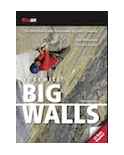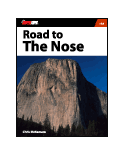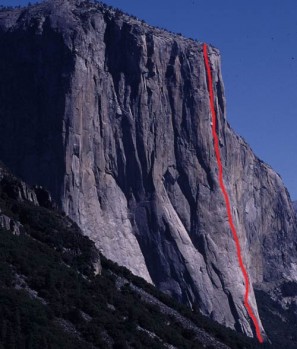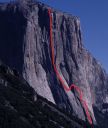The Nose, El Capitan 5.14a or 5.9 C2 |
||
Yosemite Valley, California USA | ||
| ||
|
Avg time to climb route: 5 days
Approach time: 10 minutes Descent time: 4 hours Number of pitches: 31 Height of route: 2900' Overview
Long, sustained and flawless, the Nose may be the best rock climb in the world; it is certainly the best known. On paper, at 5.9 C1, The Nose sounds easy. It’s not. With over 31 pitches of steep, exposed and strenuous climbing, The Nose is an immense physical and psychological drain. Extensive climbing experience on long routes is mandatory. The failure rate is high. That said, anyone who is deeply committed to training for this climb can do it. See our recommended Nose Rack
Photos
- View all 383 photos of The Nose as: Thumbnails | Slideshow
Climber Beta on The Nose
Which SuperTopo guidebooks include a topo for The Nose?
Find other routes like
The Nose
History
First ascent historyAfter missing a chance to make the firrst ascent of Half Dome, Warren Harding knew there was only one other accomplishment that could surpass it—the first ascent of El Capitan. Because no technical rock climb of this scale had ever been attempted, Harding employed expedition tactics of using supplied camps linked by fixed ropes. In addition, the Park Service mandated that the climbers use fixed ropes so that a rescue would not be necessary. On July 4, 1957, six days after the first ascent of Half Dome, Harding and his team began their historic journey. After reaching Sickle Ledge in three days, the team pulled off two wild pendulums and faced the next obstacle, a series of 300-foot long, 2–3" wide cracks. Standard pitons that large did not exist, but Harding had come prepared. He had four enameled stove legs that Frank Tarver had scrounged from a Berkeley dump. Leapfrogging the 9" monsters up the continuously wide cracks, the team made it to within 100 feet of Dolt Tower before descending. The climb was a huge tourist attraction, and traffic became so tangled that the Park Service ordered a halt to the project until fall. Even under the best of circumstances climbers were viewed as a nuisance by the Park Service—“Somewhere between hippies and bears,” noted Wayne Merry, a member of Harding’s team. Despite their lack of warm feelings for the project, the Park Service lifted the ban as promised and Harding’s team pushed up to Dolt Tower before descending for the winter, leaving fixed ropes attached to the wall. Fixed ropes reduced the fright of being on such a colossal wall, but because they were made of manila and left swaying in the wind for months on end, the ropes presented a danger in themselves. Steve Roper describes a close call: “Wally Reed had just begun prusiking up a section of rope when suddenly he plummeted back onto a ledge. The rope had broken. Luckily the ledge was a fair-sized one and he didn’t roll off.” In May 1958, Harding and the team reached the Boot Flake, a feature that mysteriously floats on the wall with no visible means of attachment. Each pin placement caused the whole feature to groan and expand. On top of The Boot, seeking the next crack system, Harding unleashed the wildest pendulum ever done, now renowned as the King Swing. By fall the route was pushed up to Camp IV, and both climbers and the Park Service wanted to wrap things up. Harding had been the leader from the start, and as problems arose and partners bailed, it was his determination that kept the project alive. Of the eight climbers who contributed to the first ascent, only Harding was involved for the duration. On November 1, 1958, the team, now consisting of Harding, Merry, Rich Calderwood and George Whitmore, prusiked to their high point at 1,900 feet, and launched their summit campaign. The Great Roof, although appearing from the ground to be the crux of the route, was easily dispatched, and the climbers moved steadily up to Camp VI. At this point Calderwood suddenly dropped out, leaving Whitmore to move loads and Harding and Merry to swing leads up the spectacular upper dihedrals. After enduring a storm on November 10, they reached a small ledge 180 feet below the summit. Above them loomed a blank and overhanging wall. At 6 p.m. the next day Whitmore came up the fixed ropes, which now spanned 2,800 feet of the wall, and delivered a fresh supply of bolts to Harding. What followed was described by Steve Roper in Camp 4 as “the most famous single episode in Yosemite’s illustrious climbing history.” For 14 hours, from dusk till dawn, Harding endured the unimaginable pain of hand drilling 28 bolts in a row by headlamp. At 6 a.m. he stood exhausted but triumphant on the summit, greeted by hordes of friends and media who created a huge commotion unlike that prompted by any previous climb. Scaling El Capitan had required 45 days of climbing over 18 months and had consumed 125 bolts. The triumph shook both the climbing and non-climbing worlds and would change big wall climbing forever. The term “impossible climb” would never again be used as easily. Within a few years the rush was on to climb in Yosemite. Other history In 1960, Royal Robbins, Tom Frost, Chuck Pratt, and Joe Fitchen made the second ascent of the Nose. This significant ascent, the first continuous ascent of El Capitan, proved that an enormous wall could be climbed without siege tactics, and it paved the way for the bold big wall ascents of the 60s. Jim Bridwell, John Long, and Billy Westbay made the first one-day ascent of the Nose in 1975. Their 15-hour dash laid the groundwork for the speed climbing that would grip the Valley in later years. In 1981, Ray Jardine, the inventor of Friends, launched the first major attempt to free climb the Nose. Just below El Cap Tower the possible free route traversed 30 feet on what Jardine hoped would be 5.11 terrain. He found the moves were actually much harder, so he used a cold chisel and manufactured 5.11. Jardine’s motive was his vision of Numero Uno, a route up El Cap that was moderate, and accessible to the masses. In 1993, Lynn Hill approached the climb with a much different philosophy. After Jardine, many top climbers had attempted to free climb the Nose, but none was able to unlock sequences on the Great Roof or the Changing Corners. On her first attempt in 1993, Hill freed every pitch to Camp VI, including the Great Roof—an incredible feat still unrepeated on lead. A few pitches higher on the Changing Corners pitch, a fixed piton lodged in a crucial finger lock blocked the free ascent. Returning to the summit a few weeks later with Brooke Sandahl, Hill removed the offending piton and worked the extremely technical moves. It looked like it would go! Hill and Sandahl returned to the base and began their ground-up free ascent. Hill climbed the Great Roof first try and moved to the crux Changing Corners pitch. Here she employed what she called “a bizarre sequence of moves involving delicate smears, stems, back-stepping, liebacking, arm bars, pinching, palming, etc.” Again, she sent the pitch first try, and after four days of spectacular free climbing, Hill and Sandahl stood on the summit. The Nose was free. It is hard to top one of the great free climbing achievements of all time, but the next year Hill herself found a way. Starting at 10 p.m. on a September evening, Hill spent the next 23 hours climbing every pitch free, making the first one-day free ascent of the Nose. Strategy
The Nose requires a fast and light strategy. Although many parties climb the route in more than four days, hauling that much food and water is not pretty. The route has little mandatory free climbing, but it is more enjoyable and goes faster if you can free 5.10. The Nose is the most popular route on El Cap, so prepare to wait in line for two days at the base. Most parties spend the first day hiking loads to the base and fixing to Sickle Ledge. Fixing gives a head start but increases the logistics of the climb. If you aim to do the route in two nights, bivy at El Cap Tower and Camp V. If you are aiming for three nights, bivy on Dolt Tower, Camp IV, and Camp VI. The ASCA and others have replaced almost all lead and belay bolts.Retreat
The Nose is set up for easy bailing from the last pitch all the way to the ground. It is much easier to retreat from the route with 60m ropes. In a storm the upper part of the wall, especially Camp VI, receives lots of runoff. Many rescues and a few deaths have resulted from parties not being equipped with adequate storm gear.Approach
From El Capitan Meadow, pick up the distinct trail that starts 300 feet west of El Capitan Bridge. Follow the trail to a large clearing. When facing the wall, walk at 10 o’clock and pick up the climbers' trail that eventually leads to a point 200 feet in front of the toe of the Southeast Buttress and the start of the Nose. From here, the trail diverges to skirt either the base of the Southeast Face or Southwest Face. It’s about a quarter mile and a 10-15-minute walk from the road to the toe of the Southeast Buttress and the start of The Nose. From there, it is an additional 20-30 minutes to reach the start of Lurking Fear or Zodiac.Descent
The 2-3 hour East Ledges Descent is the fastest, most convenient way to descend from El Capitan. It spares your knees the long hike down either the Yosemite Falls Trail or Tamarack Flat Trail.From the summit of most routes, hike east, staying 100 feet from the edge of El Capitan until you reach a long and distinct 30-40-foot-wide drainage just below the Zodiac finish. (For the Lurking Fear/West Buttress Finish, begin by hiking away from the edge and east until you escape slabby and brushy terrain. Then turn and head down and a little east back to the edge of El Capitan.) Follow the drainage down until 80 feet before a 2,000-foot drop-off into Horsetail Falls (often dry). Enter the manzanita bushes on a well-worn trail that after 5-10 minutes will hug the left wall. Continue along the wall until bushes end and scramble down 3rd-class terrain for about 100 feet to a ledge that is roughly perpendicular to The Wild Dikes, a south-facing black wall streaked with white. Read the following text while referencing the descent topo in the book "Yosemite Big Walls: SuperTopo": For rap routes A and B, move down 15 feet of 4th class and cut right (south) across a 20-foot wide drainage gully. Walk/slide down the right side of the gully for 30-50 feet. Exit onto the south (right) shoulder and cruise down 40 feet to a ledge. For rap route A, continue toward the edge and down a 20-foot 4th-class section to a tree wrapped with slings. For rap route B (the only route you can rap with one 60m rope), head left and down 30 feet of scree, then move right over exposed 4th-class rock. Work right, through a bush, to a 4’ x 6’ flat ledge with a small tree. Rap route C (see topo) is not recommended. From the base of the rappels, head east down multiple 3rd-class sections joined by faint trails. Eventually, a defined trail will emerge. Follow it down to a boulder strewn drainage, immediately crossing to a trail paralleling the drainage for 300 feet before it breaks off into the trees to the Manure Pile parking lot, about one mile from El Cap Meadow. If you’re caught in a storm or descending at night and are unfamiliar with the East Ledges descent, take the tedious, 4-5-hour Yosemite Falls Trail descent instead. Pick up the Falls Trail from the summit of El Capitan (see map page 42 of Yosemite Big Walls). Everything You Need to Know About
Yosemite Valley
Search the internet for beta on
The Nose
Links to related internet pages with info on The Nose
|
Other Routes on El Capitan
|











